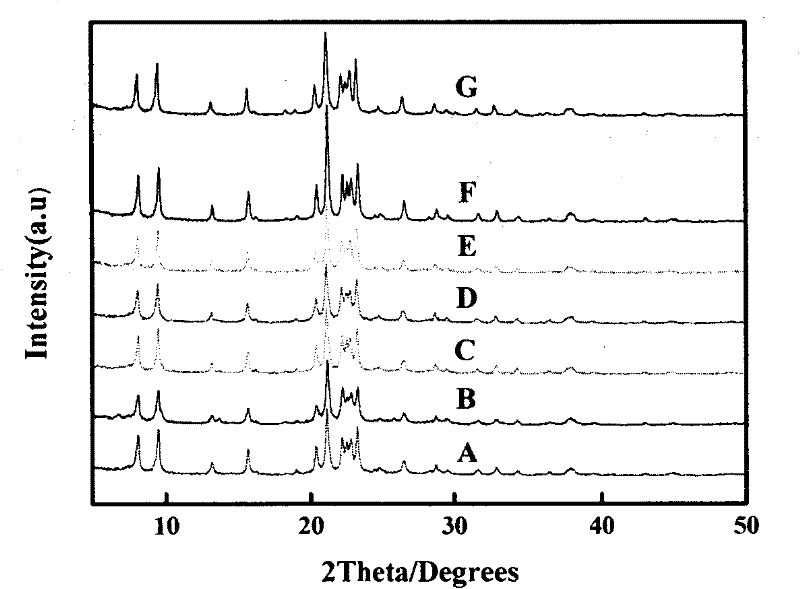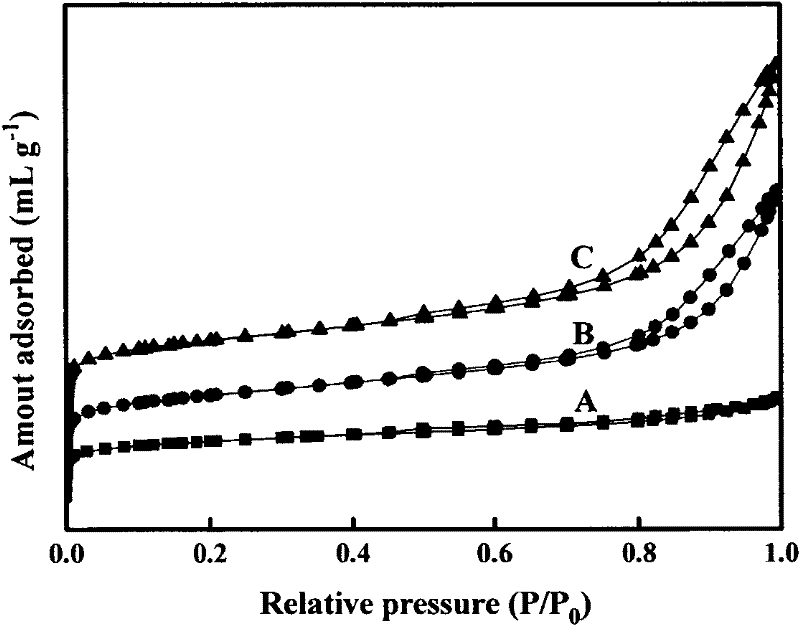Method for synthesizing SAPO-11 molecular sieve by using long chain alkyl silane as silicon source
A SAPO-11, 1. SAPO-11 technology, applied in the field of preparation of SAPO-11 molecular sieve, can solve the problems of small external surface area, small number of pores, difficult and multi-branched isomerization reaction, etc., and achieve high isomerization performance, The effect of slowing down the rapid polycondensation and promoting the crystallization process
- Summary
- Abstract
- Description
- Claims
- Application Information
AI Technical Summary
Problems solved by technology
Method used
Image
Examples
Embodiment 1
[0028] Example 1 Synthesis of SAPO-11 molecular sieve with n-hexadecyltrimethoxysilane as silicon source
[0029]Mix 13.6g of phosphoric acid (AR, 85%) and 45g of deionized water uniformly in a 35°C water bath, add 9g of pseudoboehmite, and magnetically stir in a 35°C water bath for 2 hours to obtain an aluminum phosphate sol; Hexaalkyltrimethoxysilane [C 12 h 25 Si(CH 3 O) 3 ] (97%) was pre-hydrolyzed in 10 g of water for 1 h, then added to the aluminum phosphate sol (the molar ratio of the amount of n-hexadecyltrimethoxysilane added to the aluminum source was 0.3:1), and continued to stir in a water bath at 35 ° C After 2h, slowly add 7.9g di-n-propylamine (AR, 99%) again, continue stirring 2h to form homogeneous sol (mixed solution), the mol ratio of reaction system material is Al 2 o 3 :P 2 o 5 : SiO 2 :DPA:H 2 O=1:0.95:0.3:1.2:50;
[0030] Put the sol into a polytetrafluoroethylene autoclave, crystallize at 185°C for 48h, then centrifuge, wash the solid product ...
Embodiment 2
[0039] Example 2 Synthesis of SAPO-11 molecular sieve with n-octyltriethoxysilane as silicon source
[0040] The 6.5g of n-hexadecyltrimethoxysilane in Example 1 was changed to 5.2g of n-octyltriethoxysilane, and the composition and operating conditions of the rest of the reactants were the same as in Example 1.
[0041] The XRD characterization results of the obtained SAPO-11 molecular sieve are shown in figure 1 In the curve D, the pore structure data are shown in Table 1.
Embodiment 3
[0042] Example 3 Synthesis of SAPO-11 molecular sieve with dimethyl n-octadecyl[3-trimethoxysilylpropyl]ammonium chloride and ethyl orthosilicate as silicon source
[0043] Change the 6.5g n-hexadecyltrimethoxysilane in embodiment 1 into 2g ethyl orthosilicate and 4.6g dimethyl n-octadecyl [3-trimethoxysilyl propyl] ammonium chloride ( BC, biochemical reagent), the molar ratio of ethyl orthosilicate and dimethyl n-octadecyl [3-trimethoxysilylpropyl] ammonium chloride is 1: 1, and the composition of the remaining reactants and operating conditions and implementation Example 1 is the same.
[0044] The XRD characterization results of the obtained SAPO-11 molecular sieve are shown in figure 1 In curve C, the pore structure data are shown in Table 1.
PUM
| Property | Measurement | Unit |
|---|---|---|
| particle diameter | aaaaa | aaaaa |
Abstract
Description
Claims
Application Information
 Login to View More
Login to View More - R&D Engineer
- R&D Manager
- IP Professional
- Industry Leading Data Capabilities
- Powerful AI technology
- Patent DNA Extraction
Browse by: Latest US Patents, China's latest patents, Technical Efficacy Thesaurus, Application Domain, Technology Topic, Popular Technical Reports.
© 2024 PatSnap. All rights reserved.Legal|Privacy policy|Modern Slavery Act Transparency Statement|Sitemap|About US| Contact US: help@patsnap.com










